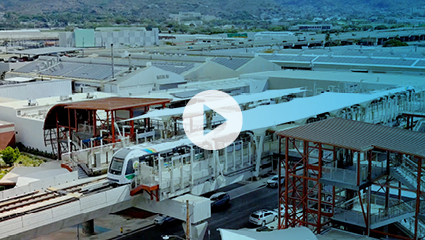Honolulu Rail Transit Project
This is an automated, driverless rail system known as Skyline, running along Oʻahu’s south shore from East Kapolei Station to a temporary terminus at Civic Center Station. The alignment is fully elevated, except for a 0.6-mile at-grade section near Leeward Community College Station. Skyline is electrically powered via a third rail and operates with a fleet of twenty four-car trains.
About the Project
As part of the Federal Transit Administration’s (FTA) accepted 2022 Recovery Plan, HART and the City and County of Honolulu amended the scope of the project by postponing the final 1.25 miles of guideway, the last two stations (Kaka‘ako and Ala Moana), and the Pearl Highlands Parking Garage. The revised project now consists of 18.9 miles and 19 stations from East Kapolei to Civic Center.
The Environmental Re-Evaluation has been completed, and the amended Full Funding Grant Agreement (FFGA) was accepted. Future project phases will include the extension from Civic Center Station to the Ala Moana Transit Center and the Pearl Highlands parking facility.
With the Recovery Plan in place, HART continues to report project progress based on the revised scope and schedule.
Documents:
> 2022 Recovery Plan
> Amended Full Funding Grand Agreement (FFGA)
Administrative Record Archive
Benefits of the Honolulu Rail Transit Project
The guideway is an elevated structure, except for a 0.6-mile at-grade section near Leeward Community College. The exclusive right-of-way will achieve rapid, more reliable service than with only buses operating on congested streets.
The route will provide transportation in various areas and communities of limited mobility and low income and help serve keiki to kupuna.
The Honolulu Rail Transit Project provides service to rapidly developing areas.
Rail will be fully integrated with the City bus system. A single system-wide transit smart card will be used by passengers to move seamlessly between TheBus and the rail system.
Opportunities for transit-oriented development (TOD) along the alignment.
Future opportunities to extend the project to Ala Moana Transit Center and, ultimately, to the University of Hawaiʻi (UH) at Mānoa.
Project Milestones
Summer 2005
Hawaiʻi State Legislature authorizes a 0.5% General Excise Tax (GET) for local mass transit funding.
December 2006
Honolulu City Council selects Kapolei-Waikīkī fixed guideway system as the Locally Preferred.
February 2007
Honolulu City Council recommends 20-mile East Kapolei to Ala Moana Center route for the first construction phase.
November 2008
Voters confirm steel-wheel on steel-rail technology. City completes Draft Environmental Impact Statement.
February 2009
Officials shift the route from Salt Lake to the Honolulu International Airport.
November 2010
Voters establish HART as a semi-autonomous authority to build and operate the rail transit system.
December 2010
Governor Neil Abercrombie accepts the project’s Environmental Impact Statement (EIS).
January 2011
Federal Transit Administration (FTA) issues a Record of Decision to approve construction.
February 2011
Ceremonial project groundbreaking held at the site of the Kualaka‘i (East Kapolei) Station.
August 2012
State Supreme Court rules that archaeological studies were improperly phased. Construction activities are halted.
December 2012
FTA issues a Full Funding Grant Agreement (FFGA) to provide $1.55 billion to construct the project, or about 32% of the estimated $5.1 billion project cost.
September 2013
HART completes the archaeological studies and Supplemental EIS. Permits are reissued and construction resumes.
January 2016
Hawai‘i State Legislature extends 0.5% GET to raise an additional $1.2 billion for the project, lasting until 2027.
November 2016
Rail operations transferred from HART to Department of Transportation Services.
September 2017
Hawai‘i State Legislature extends 0.5% GET and raises the Transient Accommodation Tax by 1% to raise $2.4 billion, lasting until December 2030.
September 2020
HART energizes the third rail and begins Dynamic train testing between East Kapolei to Aloha Stadium.
November 2020
HART terminates the procurement of Public-Private Partnership (P3) contract for the construction of the City Center Guideway and Stations segment of the project.
December 2021
Honolulu City Council approved Bill 40 to implement a 3% new City Transient Accommodations Tax on visitor accommodations, allocating revenue for the rail project.
May 2022
HART awards CCUR III Downtown construction contract to Frank V. Coluccio Construction Company, Inc.
June 2022
HART submitted a 2022 Recovery Plan, proposing a change in scope for the project.
August 2022
HART awards CCUR IV Dillingham construction contract to Nan, Inc.
September 2022
FTA accepts HART’s 2022 Recovery Plan, triggering the need for an amendment to the original FFGA.
October 2022
HART and Hitachi Rail Honolulu conduct emergency training exercise between East Kapolei and UH-West O‘ahu Stations with the City’s first responders.
June 2023
HART transfers 10.75 miles of guideway, 9 stations, the 43-acre Rail Operations Center and Maintenance and Storage Facility, and 12 four-car trains to the City’s Department of Transportation Services. Skyline’s Segment 1 opens and begins passenger service on June 30.
February 2024
Honolulu Mayor Rick Blangiardi and HART Executive Director and CEO Lori Kahikina sign the amended FFGA with the FTA.
April 2024
HART received $125M in federal funding for the project from the FTA. This is the first federal funding received since 2017.
August 2024
HART awards City Center Guideway and Stations (CCGS) Design-Build Contract to Tutor Perini Corporation.
August 2025
Groundbreaking and blessing held at the site of future Ka‘ākaukukui Station (Civic Center) Station.
October 2025
HART transfers 5.2 miles of guideway, 4 stations, and 7 four-car trains to the City’s Department of Transportation Services. Skyline’s Segment 2 opens for passenger service on October 16, bringing the current project scope to 84% complete with 13 of 19 stations now in service.
HART Weekly eBlast
Our weekly newsletter will keep you up-to-date about the project, news, construction, and information on upcoming events.
Project Status
The Overall Construction and Design Project Progress is based on the Estimate at Completion for the 2022 Recovery Plan scope to Ka‘ākaukukui (Civic Center) Station and the March 2031 Operational Readiness date.

